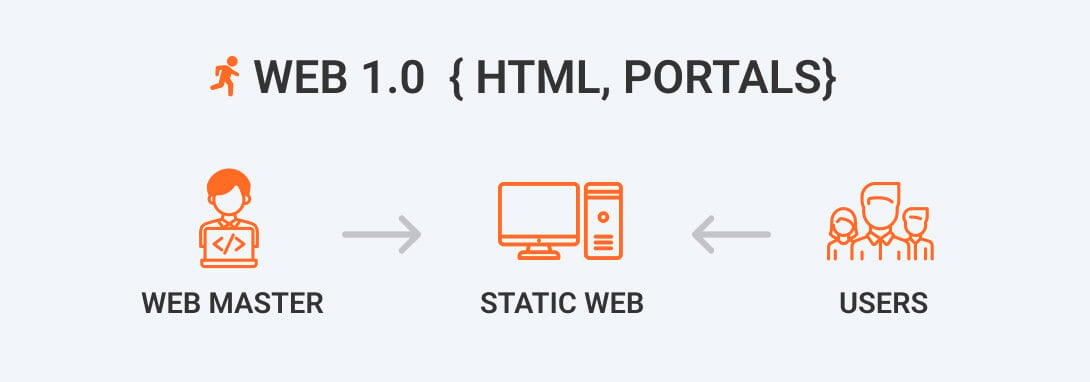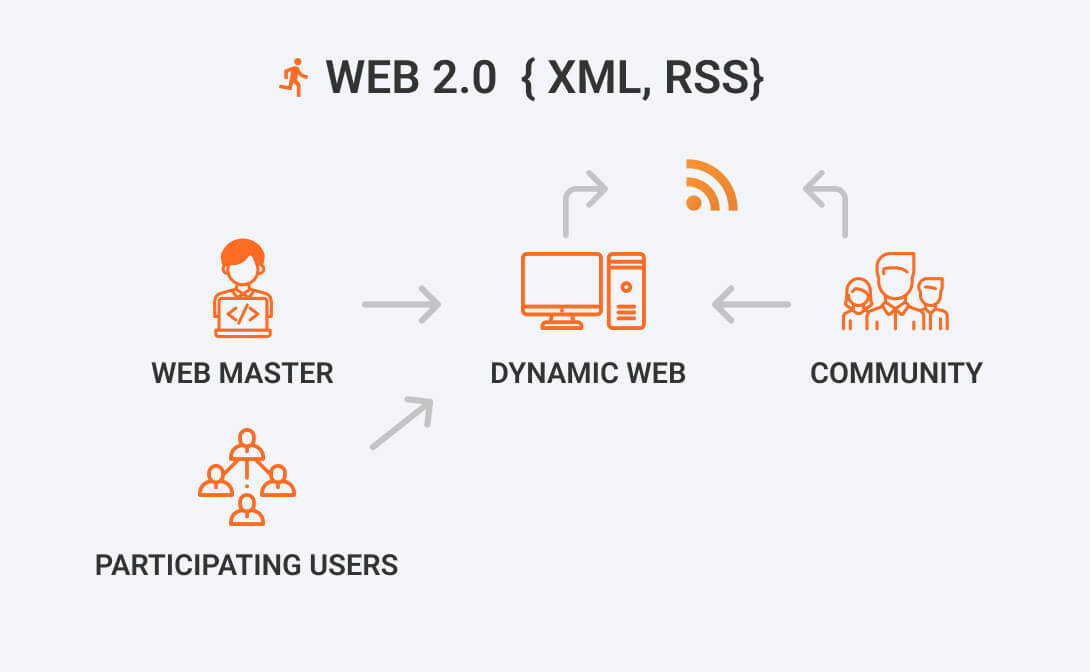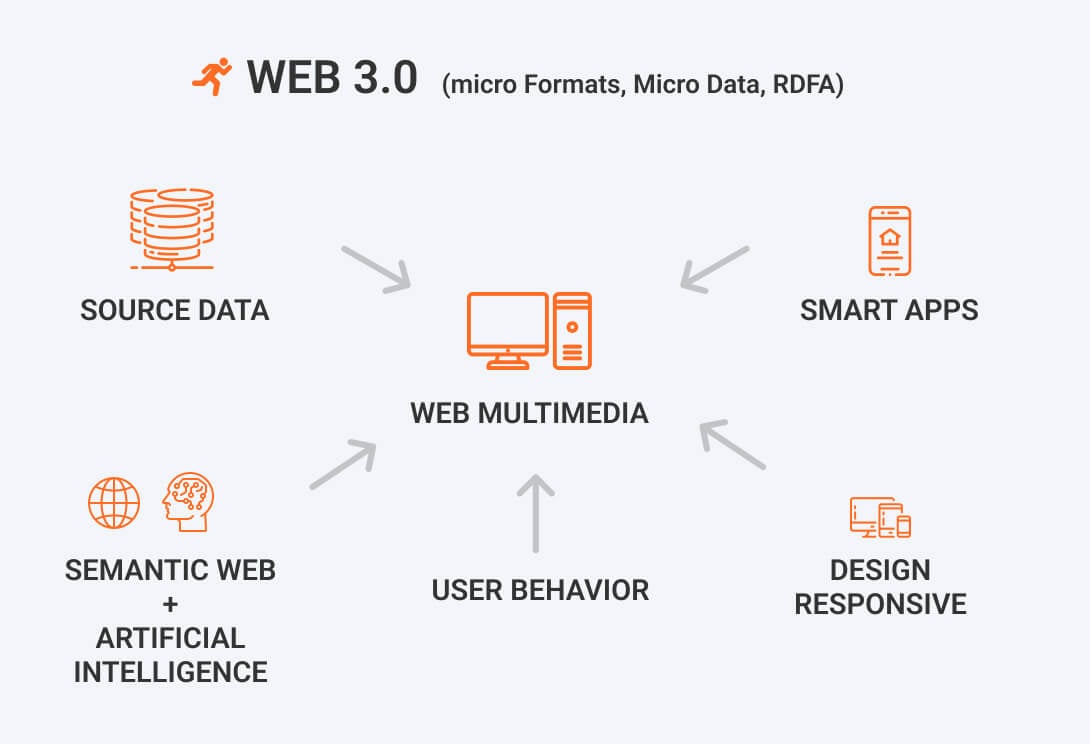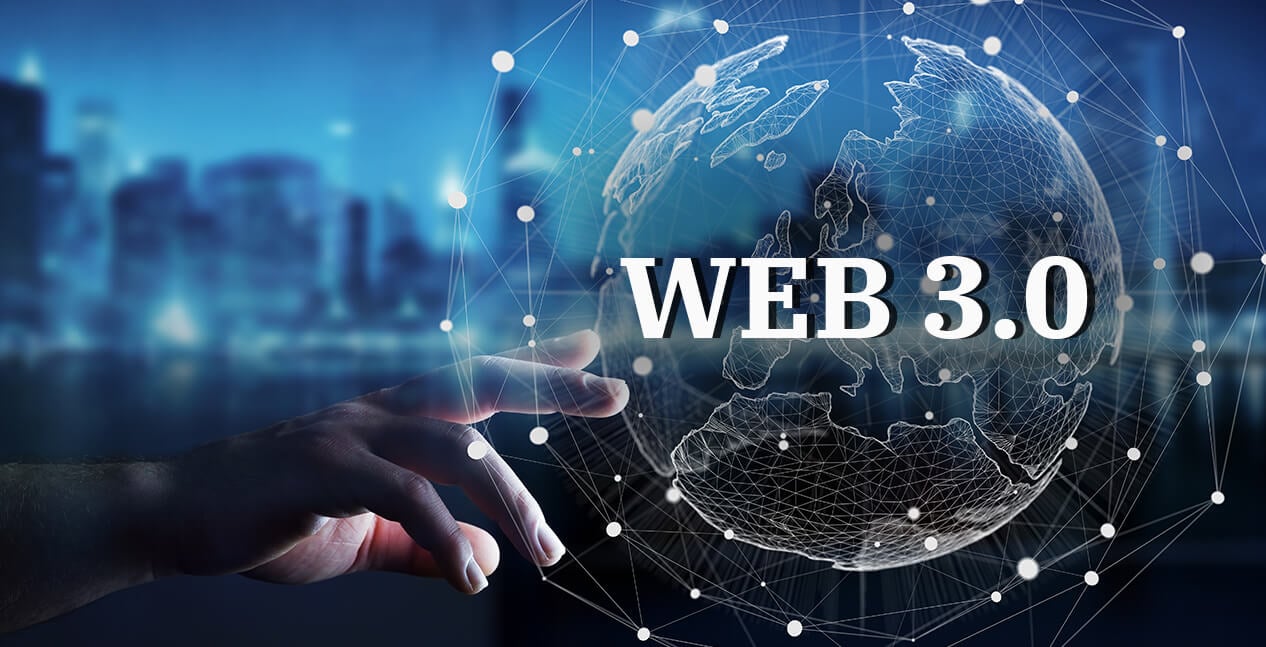What is Web 3.0?
Web 3.0 is the next generation of the Internet which grants websites and applications the ability to process data intelligently through Machine Learning (ML), Decentralised Ledger Technology, AI, etc. This blockchain technology-based World Wide Web was also termed as Semantic web because it is deemed to be intelligent and autonomous. Apparently, it will become a platform for the coming generations to have a secure and authentic repository of information that is immutable and accessible to all, eliminating cyber crimes. It will also provide complete ownership of the data and tokens shared on the internet by the user to ensure identity preservation.
Evolution of Web 3.0
Web 3.0 is said to have evolved from its basic versions – web 1.0 and web 2.0. Let’s deep dive into this phase-wise evolution of the internet to understand why web 3.0 was a necessity.

– Web 1.0
Web 1.0 is a Content Delivery Network (CDN), also known as a Read-only network defining the advent of the internet. This was the era between 1990-2004 when the web was static, and the users could only consume information given on the web pages hosted through web servers.
Unlike today, the web pages were hardly interactive since the content creation was still in its infant stage. Berners-Lee, the creator of the fundamental technologies of the web – HTTP, HTML, and URL precisely, had given shape to the first global network. Web 1.0 had in fact carved the way for future digital interactions. As the internet was gradually adopted by different industries, especially the banking sector, the need for interactive web became a necessity. The more people wanted to consume the information, the more they needed to produce and share too which paved the way for web 2.0.
– Web 2.0

Web 2.0 was a major transition period in the web world between 2004 – 2012. Until now, the users were only consuming data that was at their disposal. However, as the web technologies evolved, user-generated data could be viewed by people around the world through the newly created social media webs. MySpace and Friendster were amongst the first startups that gave a platform to users to interact with each other. The advent of the mobile internet was also one of the key driving factors in this transition. With the introduction of mobile internet and the origin of big companies like Apple, Amazon, Facebook and Google, people could now share their experiences, businesses, etc with the world as well. This reformation led to people generating income from online services like delivery, product sale online, renting properties online and many such services. However, some industries like advertising, entertainment, etc were hit to their existential point. As web 2.0 gave users the leverage to share their data, most of the industry giants took over. They made users dependable to share their data worldwide through their platform and ownership of the shared data became a big issue. Identity theft is the most prominent reason web 3.0 was needed.
– Web 3.0

Web 3.0 first emerged in 2006 and brought an evolution in the way the web has been utilized until now. This semantic web understands the context and concept of the data to deliver the most accurate results. Until now the big giants like Google and Microsoft had been consuming user data without compensating the people whose data is being shared online. However, with web 3.0, now people can claim ownership of the data or information they share. They will be able to sell their data and assets without losing privacy and ownership and earn out of it. Moreover, due to Artificial Intelligence and Machine Learning, humans will be able to communicate with machines just like they would communicate with other humans.
Difference between Web 1.0, Web 2.0, and Web 3.0 –
| Web 1.0 | Web 2.0 | Web 3.0 |
| Read-only | Read-write | Read-write-execute |
| Owning content | Sharing content | Consolidating content |
| Home pages | Blogs and Wikipedias | Live streams |
| Directories | Tagging | User behavior |
| Page Views | Cost per click | User engagement |
| HTML/ Portals | XML/RSS | OWL/ RDF/ RDFS |
| Web Forms | Web Applications | Smart Applications |
| Company focus | Community focus | Individual focus |
Features of Web 3.0
1. Decentralisation
Decentralization of data is the core feature of web 3.0. Earlier computers used to search for information by using HTTPS that stored the information at a single location, on a single server. However, Web 3.0 started using the process where information is searched by the user query/ content available anywhere on the net. Therefore, with the advent of web 3.0, data could be distributed and stored at multiple locations.
2. Semantic Web
The semantic web is an extension of the world-wide-web which enables computers to comprehend data by extracting relevant interpretations via data descriptors. According to the founder of Semantic Web, Tim Berners-Lee, this technology helps computers to analyze various types of content and deduce similarities between them to deliver the best possible results. Web-users will therefore have a similar experience like humans conversing with each other.
3. Artificial Intelligence
Through semantic web concepts, it is possible for computers to understand data just like humans. With the help of Machine learning, web 3.0 will be able to produce more accurate results. These skills will help many industries to generate research data quickly and produce positive results with every query.
4. Permissionless and trustless
Web 3.0 is trustless and permissionless because Web 3.0 applications will run on Blockchains or peer-to-peer networks. This kind of network will allow people to connect directly without any intermediary and anyone will be able to access and participate without seeking any kind of authorization.
5. Data Ownership
Over the years, big companies have been controlling user-generated data and using it for their profitability. However, with web 3.0 end-users will have complete ownership of the data. Users can make money out of the information they share
6. 3D Graphics
Web 3.0 is also called the Spatial web as it brings 3D virtual worlds into focus. 3D graphics bring a whole new level of innovation in the sectors like health, real estate, gaming, e-commerce, etc.
7. Ubiquity
Decentralization of data brings accessibility to content through multiple applications and thus, any form of information or services can be leveraged from any location. With web 3.0, data can be shared at any time, anywhere, using smart devices. This data could be used in any manner as per user requirements.
Top use cases of web 3.0 in 2022
Web 3.0 is the beginning of a 3rd world where people and machine interactivity is at its best. Here are some of the top examples of web 3.0 applications that are setting the tone for the next generation of web, which is more advanced, more secure and whatever data you feed in that web will surely be under your control and ownership.
#Siri
We have gotten accustomed to the voice recognition system, all thanks to Siri! It is the perfect example of web 3.0 where a mobile or tab user communicates with the machine and based on the user’s query, the machine/device fetches accurate search results. Though until now Siri has been able to follow basic commands as per the algorithm fed in the device, with web 3.0 it will be able to provide step-by-step guidelines for things.
#Sapien
Sapien web 3 app is a decentralized social network tool that is released on a Blockchain-based platform. This application allows users to build Ethereum based Blockchain applications with no requirements for payments and ads. This application also offers services and technologies that help people to communicate, share, transact and create multiple communities using tools.
#Everledger
Everledger is a tracking company that uses Blockchain technology to track the supply chain of diamonds, golds, wine,etc. This platform keeps track of every minute detail of the tracking item and where and how the item was used. Consumers can also verify their purchase items securely by scanning Everledger’s sticker. Everledger is also claiming an RFID chip patent that will be used by consumers to access their lost items.
#Ethlance
Ethlance is a job-searching platform that helps people to apply for jobs. The platform helps candidates to connect with employers who search for qualified applicants. It also eliminates employers’ and freelancers’ barriers. This decentralized marketplace helps artists and content creators to earn big profits and at the same time ensures 100% ownership of work freelancers provide
#StorJ
StorJ is a decentralized cloud storage platform that allows users to store their files on the network. It also allows other users on the network to sell the storage space they have to other users and earn money out of it. One of the most intriguing features of StorJ is that it allows users to set an expiration date for the data they have stored which gets self-destructed after the set date.
#Brave
Brave is claimed to be one of the most secure browsers to date. It guarantees all kinds of invasive ads blockage, cookies blockage, cross-site tracker blockage and provides malware & phishing protection. Brave also promises to block trackers and deliver complete privacy to users by leveraging Blockchain technology. Moreover, it is faster as well as more secure than Google or any other mainstream browser.
#Akasha
Akasha is a social networking site where users can build communities, create their profiles, can share content, and make money. It is an open platform where communities can easily connect with each other and share thoughts, experiences, and information. Unlike Instagram or Facebook where the user account is flooded with advertisements, this platform blocks all such promotional activities, helping users to maintain their privacy.
To wind-up
Web 3.0 is a massive transformation that will build the internet from the ground up. Since it is a decentralized web, you get ownership of the information you feed on the internet. This implies that none of the firms would have control over the user’s online activities. Blockchain development services play a pivotal role in this evolution by ensuring data integrity and security through blockchain technology. Also, the change of platforms will help users to enjoy their privacy without having to get bugged by ads and other promotional stuff.
Web 3.0 eliminates the need for a middle man during transactions, further emphasizing the importance of Blockchain technology and streamlining operations. This in turn enforces more collaboration between partners, customers, and employees, to bring more profitability to any business per se. Therefore, with web 3.0 already rolled down, the internet is definitely going to improvise the traditional way of operations, making users more authoritative and bringing all-around transparency in all kinds of dealings.








